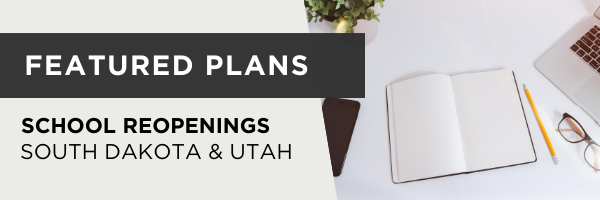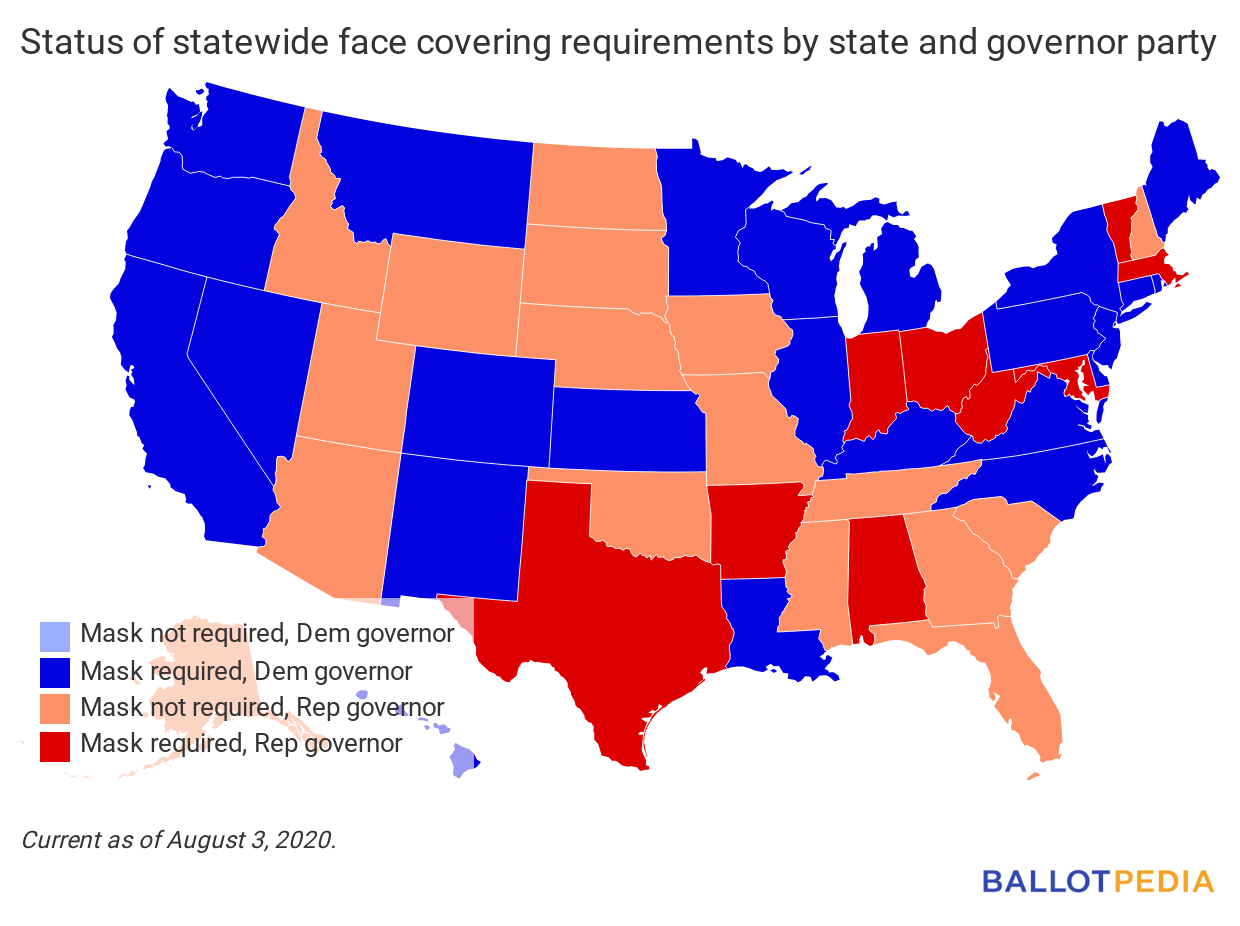Each day, we:
Want to know what happened Friday? Click here. Since our last editionWhat is open in each state? For a continually updated article on reopening status in all 50 states, click here. For our last edition, click here.
Tracking industries: Face coveringsAll 50 states are reopening in some way. Here, we give the status of one industry or activity across the states. Today’s question: in which states must you wear a face covering in public? We last looked at face coverings in the July 27th edition of the newsletter. Since then, no states have enacted or rescinded a mask mandate.
|
||||||||||||||||||||||||||||||||||||||||||||||||||||||||||||||||||||||||||||||||||||||||||||||||||||||||||||||||||

This is an in-depth summary of two state plans to reopen public K-12 schools for the 2020-2021 school year. South Dakota’s Starting Well 2020In June, the South Dakota Department of Education partnered with the Department of Health to release “Starting Well 2020,” a series of documents containing guidance on reopening and daily operations for K-12 schools. The documents cover several areas, including guidelines for teachers, special education, libraries, distance learning, school buses, and COVID-19 mitigation. Many of the guidelines were updated throughout July. South Dakota does not have a statewide date for public schools to reopen. According to EdWeek, schools in South Dakota typically start in mid-August. On March 17, Gov. Kristi Noem (R) first ordered schools to close. On March 24, Noem extended the closures through May 1. On April 6, Noem ordered schools to close to in-person instruction for the remainder of the academic year. ContextSouth Dakota is a Republican trifecta. The governor is a Republican, and Republicans have majorities in both chambers of the state legislature. The following tables show public education statistics in South Dakota, including a rank comparing it to the other 49 states. Rank one is the highest number of each figure, rank 50 is the lowest. All data comes from the Common Core of Data provided by the National Center for Education Statistics.
DetailsDistrict reopening plans “Starting Well 2020” calls for school leaders to “develop plans in concert with local government and state health officials, using the Centers for Disease Control and Prevention and the South Dakota Department of Health as key resources to inform their decision making.” The guidance says plans should be adaptable to changing conditions. It also asks schools to communicate their plans with staff, students, and communities. The state does not need to approve schools’ plans. “Starting Well 2020” contains the following guiding principles for schools:
In-person, hybrid, and online learning “Starting Well 2020” says “Schools will provide instruction in the fall and throughout the 2020-21 school year, with a priority placed on face-to-face instruction.” However, schools are encouraged to develop flexible plans that allow for remote learning when necessary.
Mask requirements The South Dakota Department of Education is not requiring students or staff to wear masks. The decision is left up to schools and districts. The Department of Health and Department of Education back-to-school FAQ says: “The DOH and DOE encourage school leaders to use a variety of mitigation strategies in their planning for SY 2020-21. In selecting which to use, school leaders need to balance public health considerations and current conditions of the virus in their communities with the overall health of students and staff.” In-person health recommendations and requirements Schools should answer the following questions before reopening:
The guidance includes the following information on classroom design decisions:
Transportation and busing requirements and restrictions “Starting Well 2020” including the following considerations for transportation and busing:
The Department of Health guidelines for school buses, which were last revised on July 7, recommends:
Utah’s Planning Requirements and Recommendations for K-12 School ReopeningThe Utah State Board of Education most recently updated its school reopening guidance on July 17. Gov. Gary Herbert (R) said, “We appreciate the thought, care and work that went into these requirements and recommendations. We appreciate that so many health care professionals, teachers, administrators, parents, classified workers and others devoted their energies into creating these guidelines to help keep our children and our school employees safe and healthy this coming academic year.” On July 28, the Utah Education Association asked Herbert to delay reopening schools: “We call on Gov. Gary Herbert to lead with science and safety and declare that schools in impacted areas will open remotely this fall,” the union wrote in a letter unanimously approved by its board of directors. “We call on him to declare that local school districts should NOT return to in-person learning until COVID-19 cases decline.” Utah does not have a statewide date for public schools to reopen—individual districts that meet the state’s requirements can set their own timelines, depending on the virus’ effect on their community. According to EdWeek, public schools in Utah traditionally start the academic year in mid- to late August, with the exact start date varying by district. On March 13, Gov. Herbert closed schools from March 16 to March 31. On March 23, Herbert extended the closure through May 1. The governor closed schools for the rest of the academic year on April 14. ContextUtah is a Republican trifecta. The governor is a Republican, and Republicans have majorities in both chambers of the state legislature. The state became a Republican trifecta in 2011. The following tables show public education statistics in Utah, including a rank comparing it to the other 49 states. Rank one is the highest number of each figure, rank 50 is the lowest. All data comes from the Common Core of Data provided by the National Center for Education Statistics.
DetailsDistrict reopening plans The plan says: “Local education agencies (LEAs) are required to develop comprehensive reopening plans that are approved by the local school board or charter school governing board in an open and public meeting and made available to the public on the local education agency’s and each schools’ websites by August 1, 2020.” The plans need to comply with state requirements. In-person, hybrid, and online learning Districts are responsible for choosing in-person, hybrid, or fully remote schedules depending on the coronavirus’ effect on their community and the advice of local health officials. Districts are required to offer alternative schedules (like remote options) for students and families at higher risk of severe illness. The plan also encourages local school officials to develop an online option for other not-at-risk students and families who want to opt-in. Mask requirements The plan says, “each individual, including an employee, student, or visitor” is required to wear a face covering on public school property, in compliance with Gov. Herbert’s July 9 executive order. In-person health recommendations and requirements School districts are required to develop a process to train teachers in identifying and mitigating risk in classrooms. The plan also recommends:
For specific requirements and recommendations relating to cafeterias, restrooms, assemblies, entering and exiting school buildings, recess, and special education, click here (starting on page four). Transportation and busing requirements and restrictions In creating their reopening plans, school districts are required to address the following mitigation tactics:
The plan also recommends districts:
Additional activityIn this section, we feature examples of other federal, state, and local government activity, as well as influencers relevant to recovering from the pandemic.
|
||||||||||||||||||||||||||||||||||||||||||||||||||||||||||||||||||||||||||||||||||||||||||||||||||||||||||||||||||
Documenting America’s Path to Recovery: August 3, 2020
By



